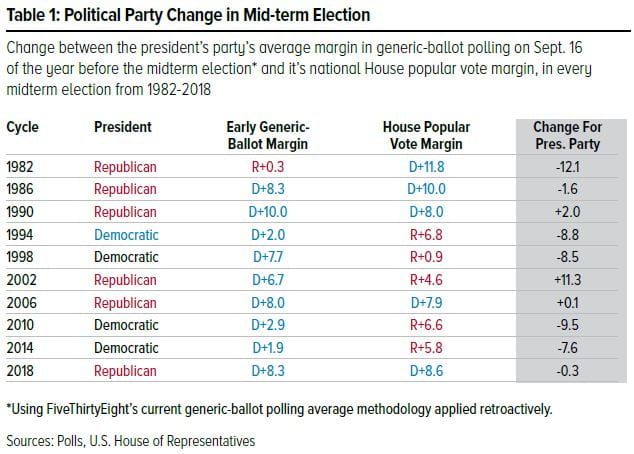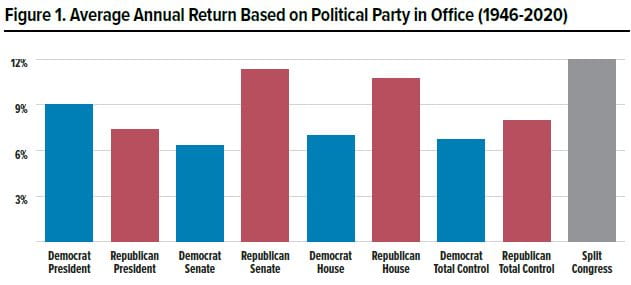Nicholas Sheppard, CFA
National Account Manager, T. Rowe Price
The 2020 election results are still fresh in the minds of many Americans, and they continue to be discussed or even contested (as in the Arizona “audit”). Election bills in Texas, Georgia, and other states are debated across the country, with a focus on voter access versus confidence in election results and their integrity. The simple civic duty of voting is now one of the most contentious topics in the country. Despite this, we are edging closer to the 2022 midterm elections, the results of which will likely determine the fate of President Biden.
In the meantime, some states are featuring hotly contested races, such as the Virginia and New Jersey gubernatorial races, in late 2021, as this article went to press. Is there anything we can glean from these very early off-cycle races to potentially predict control of the House of Representatives and Senate in 2022? This article examines three predictors of midterm election results
and market returns under various political regimes: 1) off-year election results, 2) generic ballots, and 3) the presidential approval rating. The results of this midterm cycle will determine control of Congress and potentially Joe Biden’s legacy as our 46th president.
Off-Year Elections in Virginia and New Jersey
Virginia and New Jersey feature off-year elections in 2021 that may have much broader implications for the 2022 midterm elections. In New Jersey, Democratic Governor Phil Murphy remains popular, with percentage approval ratings hovering in the mid-to-high 50s and an average nine-point lead in polls conducted since August 2021. Murphy is attempting to be the first incumbent Democrat in 44 years to be reelected governor of New Jersey.
Virginia faces a slightly more competitive race with Terry McAuliffe, former governor and chairman of the Democratic National Committee, taking on businessman Glenn Youngkin. Youngkin has committed a significant amount of his personal wealth to assist in his fundraising. The FiveThirtyEight.com polling average showed a lead of 3.3% for McAuliffe as of Sept. 30, 2021, but the race had narrowed over the several months since McAuliffe enjoyed a high single-digit lead. Could this race have even more predictive power than others?
Here’s what Jim Newell said on Slate.com on September 28:
The Virginia governor’s race has, historically, been one of the easiest races to forecast: The candidate from the party not controlling the White House would win. For 36 years beginning in 1977, the party that had lost the presidential race in the previous year won the governor’s mansion. That streak broke in 2013, when McAuliffe defeated Ken Cuccinelli during Obama’s second term in office, cementing the change in the commonwealth’s perceived political character.1
Election Day 2021 could provide insights into more than just local politics in New Jersey and Virginia. Democratic wins in those states with margins similar to Joe Biden in 2020 would be positive for Democrats. If they win, but by smaller margins, this could signal a rightward shift in the electorate. If they lose either or both races, it will almost certainly be spun as a disaster heading into 2022.
Generic Ballot
The “generic ballot”—a poll question asking whether the respondent would vote for a Democrat or Republican for Congress—has historically been a reliable indicator of midterm election results.
Where do the results stand today? Let’s take a look and dissect what they can mean for the future. As of the first release of FiveThirtyEight.com’s generic ballot polling average in September 2021, the Democrats held a small lead, with Americans preferring Democrats over Republicans, 43.8% to 41.1%.
However, early winning margins for the presidential party have often reversed, as the chart below shows. This leading indicator is not screaming a “red wave” for Republicans. However, if the trend continues, Democrats risk losing the House and potentially the Senate. Tack on the redistricting effort that is likely to benefit Republicans to the tune of as many as 10 seats from gerrymandering alone, and it’s easy to see why some Democrats are beginning to ring the alarm bell.
Presidential Approval Rating
President Biden began January 2021 with strong approval ratings, but has suffered setbacks due to frustration with the ongoing COVID-19 pandemic, inflation (transient or not), the withdrawal from Afghanistan, and immigration issues at the southern border. According to FiveThirtyEight.com’s presidential approval average, President Biden peaked at 55.1% approval in March 2021. As of late September, more Americans disapproved than approved of the job he’s doing as president: 48.8% to 45.3%. In comparison, at this time of the year, President Trump’s approval rating was 38.8% versus more than 52% for President Obama. Both of them experienced historic losses in Congress during their presidency’s first midterm election, which does not bode well for the Democrats.
Market Returns Under Different Political Regimes
The good news for investors? Regardless of the party in charge or the split, the market has performed well under the scenarios shown in the chart below.2 Split control—what some may call “partisan gridlock”—has resulted in the best returns for investors.
What mix of political control was best for stocks? Regardless of who held the White House, stocks performed best when political control of Congress was split, as in Scenario E above. Stocks returned a healthy average of 12.9% per year when the leadership of Congress was split between Democrats and Republicans, which has only happened 16% of the time.
Which Party Will Come Out Ahead?
Since the 1930s, the sitting president’s party has picked up seats in the mid-term elections only three times—including 2002, 1998, and 1934. I do not expect 2022 to buck this trend. The country is deeply polarized, so I do not anticipate a monumental red wave similar to 2010 or 1994. However, early signs point to the Republican party being positioned to capitalize at least marginally on the “midterm curse” and take back control of the House. The Senate is more complicated because Republicans face several retirements and find themselves defending more seats in this cycle.
References
1 Jim Newell, “Uh, Maybe Democrats Should Start Paying Attention to the Virginia Governor’s Race,” Slate (Sept. 28, 2021), https://slate.com/news-and-politics/2021/09/virginia-governor-terry-mcauliffe-glennyoungkin.html.
2 Mike Patton, “Stock Performance And The Political Party In Power: An Historical Look At The Past 75 Years” Forbes (Jan. 12, 2021), https://www.forbes.com/sites/mikepatton/2021/01/12/stock-performance-and-the-political-party-in-power-an-historical-lookat-the-past-75-years/?sh=5f11a8ea7a64.


